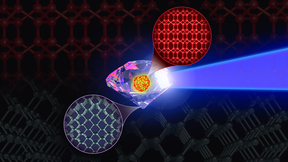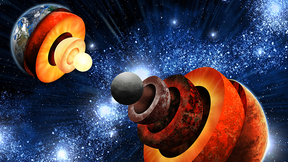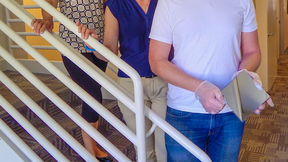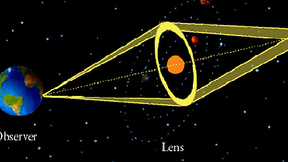Back
Astrophysics
Unveiling Bennu asteroid samples
Now at Lawrence Livermore National Laboratory (LLNL) lies a piece of ancient history. Very ancient history. The material, at just 120 milligrams, will provide information about the early solar system, planetary formation, and potentially, even ingredients for life on ancient Earth. LLNL scientists recently received and will analyze samples from the asteroid Bennu that will…
LLNL delivers compact dual-band telescope for launch this summer
Lawrence Livermore National Laboratory’s (LLNL) space hardware team has delivered a payload for NASA’s Pathfinder Technology Demonstrator-R (PTD-R) satellite. LLNL developed the optical payload, called Deep Purple, that utilizes a new design for an ultra-violet (UV) and short-wave infrared (SWIR) monolithic telescope. The mission will demonstrate simultaneous monolithic UV…
Magnesium oxide undergoes dynamic transition when it comes to super-Earth exoplanets
Researchers from Lawrence Livermore National Laboratory (LLNL) and Johns Hopkins University have unlocked new secrets about the interiors of super-Earth exoplanets, potentially revolutionizing our understanding of these distant worlds. The focus of this work, magnesium oxide (MgO), a crucial component of Earth’s lower mantle, is believed to play a similar role in the…
Jupiter Laser Facility gets a reboot
Fifty years ago, the first laser, Janus, was installed in Building 174 (renamed the Jupiter Laser Facility in 2006) at Lawrence Livermore National Laboratory. Additional lasers, more than 100 Ph.D.s granted time on the system and thousands of international users later, the Jupiter Laser Facility (JLF) celebrated its grand reopening Thursday after a four-year refurbishment,…
Mystery of puffy exoplanet solved
A recent study of the atmosphere of the exoplanet WASP-107b suggests tidal heating is responsible for the exoplanet’s inflated nature and reveals a previously unseen combination of molecules in an exoplanet. A Lawrence Livermore National Laboratory (LLNL) scientist and international collaborators have characterized the atmosphere of the exoplanet, WASP-107b, using a…
Using NIF to study the sluggish pace of star formation
Editor’s note: The principal mission of Lawrence Livermore National Laboratory (LLNL)’s National Ignition Facility (NIF) is to support the National Nuclear Security Administration’s science-based Stockpile Stewardship Program — and with the achievement of fusion ignition in 2022 at NIF, LLNL is further exploring the possible use of nuclear fusion as a future energy source…
Supercomputer simulations of super-diamond suggest a path to its creation
Diamond is the strongest material known. However, another form of carbon has been predicted to be even tougher than diamond. The challenge is how to create it on Earth. The eight-atom body-centered cubic (BC8) crystal is a distinct carbon phase: not diamond, but very similar. BC8 is predicted to be a stronger material, exhibiting a 30% greater resistance to compression…
Resolving astronomical mysteries
A new satellite called XRISM (X-ray Imaging and Spectroscopy Mission, pronounced “crism”) was successfully launched from the Tanegashima Space Center in Japan on Sep. 7, 2023. XRISM is a collaboration between the Japan Aerospace Exploration Agency (JAXA) and National Aeronautics and Space Administration (NASA), with European Space Agency participation, to study extreme…
Lab team uses giant lasers to compress iron oxide, revealing the secret interior of rocky exoplanets
Advances in astronomical observations have resulted in the discovery of an extraordinary number of extrasolar planets, some of which are believed to have a rocky composition similar to Earth. Learning more about their interior structure could provide important clues about their potential habitability. Led by Lawrence Livermore National Laboratory (LLNL), a team of…
NASA features LLNL star-formation simulations
High performance computing (HPC) simulations exploring star formation by Lawrence Livermore astrophysicist Richard Klein were among select research highlights featured by NASA at the recent supercomputing conference in Austin, Texas.Klein’s "Simulating Star Formation: From Giant Molecular Clouds to Protostellar Clusters" presentation is now on NASA’s website.The origin of…
First stars in the universe left a unique signature
Determining the chemical abundance pattern left by the earliest stars in the universe is no easy feat. A Lawrence Livermore National Laboratory (LLNL) scientist is helping to do just that.The first stars in the universe formed about 400 million years after the Big Bang (estimated at 13.8 billion years ago). Inside of these stellar furnaces, nuclear processes fused the…
New energy record set for multilayer-coated mirrors
Multilayer-coated mirrors, if used as focusing optics in the soft gamma-ray photon energy range, can enable and advance a range of scientific and technological applications that would benefit from the large improvements in sensitivity and resolution that true imaging provides. In a paper published in a recent online edition of Optics Express, LLNL postdoc Nicolai Brejnholt…
Planets around stars are the rule rather than the exception
LIVERMORE, Calif. --There are more exoplanets further away from their parent stars than originally thought, according to new astrophysics research. In a new paper appearing in the Jan. 12 edition of the journal, Nature , astrophysicist Kem Cook as part of an international collaboration, analyzed microlensing data that bridges the gap between a recent finding of planets…

















